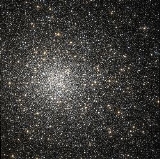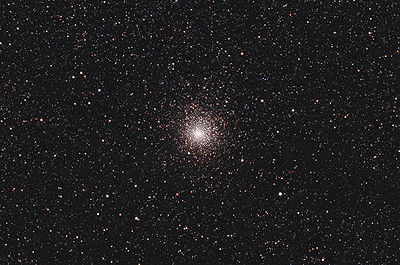
Messier 62
Encyclopedia
Messier 62 is a globular cluster
in the constellation
Ophiuchus
. It was discovered in 1771 by Charles Messier
.
M62 is at a distance of about 22,500 light-year
s from Earth
and measures some 100 light-years across.
From studies conducted in the 1970s it is known that M62 contains the high number of 89 variable star
s, many of them of the RR Lyrae
type. It also contains several X-ray sources
, thought to be close binary star
systems, as well as millisecond pulsar
s in binary systems.

Globular cluster
A globular cluster is a spherical collection of stars that orbits a galactic core as a satellite. Globular clusters are very tightly bound by gravity, which gives them their spherical shapes and relatively high stellar densities toward their centers. The name of this category of star cluster is...
in the constellation
Constellation
In modern astronomy, a constellation is an internationally defined area of the celestial sphere. These areas are grouped around asterisms, patterns formed by prominent stars within apparent proximity to one another on Earth's night sky....
Ophiuchus
Ophiuchus
Ophiuchus is a large constellation located around the celestial equator. Its name is from the Greek "serpent-bearer", and it is commonly represented as a man grasping the snake that is represented by the constellation Serpens. Ophiuchus was one of the 48 constellations listed by the 2nd-century...
. It was discovered in 1771 by Charles Messier
Charles Messier
Charles Messier was a French astronomer most notable for publishing an astronomical catalogue consisting of deep sky objects such as nebulae and star clusters that came to be known as the 110 "Messier objects"...
.
M62 is at a distance of about 22,500 light-year
Light-year
A light-year, also light year or lightyear is a unit of length, equal to just under 10 trillion kilometres...
s from Earth
Earth
Earth is the third planet from the Sun, and the densest and fifth-largest of the eight planets in the Solar System. It is also the largest of the Solar System's four terrestrial planets...
and measures some 100 light-years across.
From studies conducted in the 1970s it is known that M62 contains the high number of 89 variable star
Variable star
A star is classified as variable if its apparent magnitude as seen from Earth changes over time, whether the changes are due to variations in the star's actual luminosity, or to variations in the amount of the star's light that is blocked from reaching Earth...
s, many of them of the RR Lyrae
RR Lyrae
RR Lyrae is a variable star in the Lyra constellation. It is the prototype of the RR Lyrae variable class of stars. It has a period of about 13 hours, and oscillates between apparent magnitudes 7 and 8. Its variable nature was discovered by the Scottish astronomer Williamina Fleming at Harvard...
type. It also contains several X-ray sources
Astrophysical X-ray source
Astrophysical X-ray sources are astronomical objects with physical properties which result in the emission of X-rays.There are a number of types of astrophysical objects which emit X-rays, from galaxy clusters, through black holes in active galactic nuclei to galactic objects such as supernova...
, thought to be close binary star
Binary star
A binary star is a star system consisting of two stars orbiting around their common center of mass. The brighter star is called the primary and the other is its companion star, comes, or secondary...
systems, as well as millisecond pulsar
Millisecond pulsar
A millisecond pulsar is a pulsar with a rotational period in the range of about 1-10 milliseconds. Millisecond pulsars have been detected in the radio, X-ray, and gamma ray portions of the electromagnetic spectrum. The origin of millisecond pulsars is still unknown...
s in binary systems.


